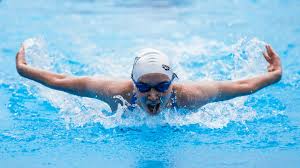Contents
ozeku.com – Swimming is a valuable life skill that can provide enjoyment, relaxation, and safety in and around water. Whether you want to swim for fun, fitness, or competition, learning how to swim can open up a world of opportunities. In this article, we’ll explore the steps to learn swimming, techniques to improve your skills, and tips for staying safe in the water.
Read More: Angry Birds 2: Evolusi dan Keberhasilan Game Legendaris
Why Learning to Swim is Important
Swimming is not only a recreational activity but also a critical life skill. Here are some reasons why learning to swim is essential:
- Safety: Knowing how to swim can save your life and the lives of others in emergencies, such as drowning incidents. It also helps you feel more confident around water.
- Health Benefits: Swimming is an excellent form of exercise that works nearly every muscle in your body. It improves cardiovascular health, builds strength, enhances flexibility, and can help with weight management.
- Social Opportunities: Swimming can be a social activity, allowing you to meet new people and engage in community events. It can also enhance your travel experiences when visiting beaches, pools, or lakes.
- Fun and Recreation: Swimming can be an enjoyable way to spend your free time, whether you’re at the beach, pool, or participating in water sports.Read More: Growtopia: Dunia Kreativitas dan Kolaborasi dalam Game Sandbox
Getting Started: Preparing to Swim
Before you dive into the pool or the ocean, here are some steps to prepare for your swimming journey:
1. Find a Suitable Location
Choose a safe and appropriate location for learning to swim. This could be a public swimming pool, a calm lake, or a supervised beach. Ensure that the area has lifeguards and is suitable for beginners sedunia toto.
2. Gather the Necessary Gear
You’ll need some basic swimming gear to enhance your comfort and safety:
- Swimsuit: Wear a comfortable swimsuit that allows for free movement.
- Goggles: These help protect your eyes from chlorine and improve visibility underwater.
- Swim Cap: A cap can help keep your hair out of your face and reduce drag in the water.
- Floatation Devices: If you’re a complete beginner, consider using floatation aids such as kickboards, pool noodles, or life jackets.
3. Warm Up
Before getting into the water, it’s important to warm up your body. Perform some light stretching and mobility exercises to prepare your muscles and joints for swimming.
Read More: Tips Bermain Blood Strike: Panduan Lengkap untuk Pemain Pemula dan Berpengalaman
Basic Swimming Techniques
Once you’re ready to get into the water, you can start learning basic swimming techniques. Here are some key strokes and skills to focus on:
1. Floating
Floating is a fundamental skill that helps you feel comfortable in the water. Follow these steps to practice floating:
- Back Float: Lie on your back with your arms extended and legs straight. Relax your body and let the water support you. Focus on keeping your head back and your hips up.
- Front Float: Lie face down in the water with your arms extended in front of you. Keep your legs together and relaxed. Allow your body to float while breathing calmly.
2. Breathing Techniques
Breathing is crucial when swimming. Here’s how to practice proper breathing techniques:
- Breathe in through your mouth when your head is out of the water and exhale through your nose when your face is submerged. This helps maintain a rhythmic breathing pattern.
- Practice breathing while floating and gradually incorporate it into your strokes as you progress.
3. Kicking
Kicking is essential for propulsion in swimming. Follow these tips for effective kicking:
- Flutter Kick: Keep your legs straight but relaxed, kicking from the hips. Alternate kicking your legs up and down while maintaining a steady rhythm.
- Practice kicking while holding onto the pool edge or using a kickboard to improve your kicking strength and technique.
4. Arm Strokes
Learn basic arm strokes that are essential for swimming:
- Freestyle Stroke: Start with one arm extended in front of you while the other arm pulls down and back through the water. Alternate arms while maintaining a steady kick. Your face should be in the water as you breathe when one arm is extended.
- Breaststroke: Extend both arms in front of you, then pull them back in a circular motion while simultaneously kicking. Keep your head above the water while breathing.
- Backstroke: Lie on your back, keep your arms straight, and alternate your arms in a circular motion while performing a flutter kick.Read More: Tips Bermain Punishing: Gray Raven: Panduan untuk Pemula dan Pemain Lanjutan
5. Combining Skills
Once you feel comfortable with the basics, practice combining your skills into a full stroke. Start with simple drills, such as swimming short distances using just your arms or legs, and gradually build up to a complete swim.
Tips for Learning to Swim

Here are some additional tips to help you learn how to swim effectively:
1. Take Swimming Lessons
Consider enrolling in swimming lessons with a qualified instructor. Professional instructors can provide personalized guidance, correct your technique, and help you build confidence in the water.
2. Practice Regularly
Consistent practice is essential for improving your swimming skills. Aim to swim at least once or twice a week to reinforce your learning and build endurance.
3. Set Goals
Establish specific, achievable goals for your swimming journey. This could include swimming a certain distance, mastering a particular stroke, or participating in a local swim event.
4. Stay Relaxed
Feeling anxious in the water is common for beginners. Practice relaxation techniques, such as deep breathing and visualization, to help calm your nerves. The more relaxed you are, the more comfortable you will feel in the water.
5. Swim with a Buddy
Swimming with a friend can provide motivation and make the experience more enjoyable. It also enhances safety, as you can look out for each other while swimming.
6. Stay Hydrated
Even when swimming, it’s important to stay hydrated. Drink plenty of water before and after your swimming sessions to keep your body well-hydrated.
7. Monitor Progress
Keep track of your progress and celebrate your achievements. This could include recording your swimming distances, noting improvements in technique, or simply acknowledging your increased comfort in the water.
Safety Tips for Swimming
Safety is paramount when it comes to swimming. Here are some essential safety tips to keep in mind:
- Always Swim with a Buddy: Never swim alone, especially in open water. Having a buddy ensures that help is available in case of an emergency.
- Follow Pool Rules: Adhere to all safety rules and regulations at swimming facilities, including depth markings, lifeguard instructions, and pool etiquette.
- Know Your Limits: Be aware of your swimming abilities and avoid pushing yourself too hard. If you feel tired or uncomfortable, take a break and rest.
- Be Cautious in Open Water: If swimming in lakes, rivers, or oceans, be aware of currents, tides, and other hazards. Always swim in designated swimming areas and be cautious of changing weather conditions.
- Wear a Life Jacket if Necessary: If you’re not a confident swimmer, especially in open water, consider wearing a life jacket for added safety.
Conclusion
Learning to swim is an enriching experience that can enhance your life in countless ways. By following the steps outlined in this guide—finding the right location, practicing essential techniques, setting goals, and prioritizing safety—you can become a confident swimmer. Remember, everyone learns at their own pace, so be patient and enjoy the journey. Happy swimming!




